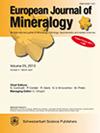Batoniite, [Al8(OH)14(H2O)18](SO4)5 ⋅ 5H2O, a new mineral with the [Al8(OH)14(H2O)18]10+ polyoxocation from the Cetine di Cotorniano Mine, Tuscany, Italy
IF 1.7
3区 地球科学
Q2 MINERALOGY
引用次数: 0
Abstract
Abstract. The new mineral batoniite, [Al8(OH)14(H2O)18](SO4)5 ⋅ 5H2O, was discovered in the Cetine di Cotorniano Mine, Chiusdino, Siena, Tuscany, Italy. It occurs as hemispherical aggregates composed of brittle tabular crystals, up to 1 mm in size, white to colorless in color, with a white streak and a vitreous to greasy luster. Batoniite is biaxial negative, with α= 1.4833(6), β= 1.4948(6), γ= 1.5019(5) (589 nm), and 2V(meas.)= 71(1)∘. Electron microprobe analysis, affected by the dehydration of batoniite under the chamber vacuum, gave (in wt %) the following: Al2O3 33.48, Fe2O3 0.05, SO3 33.00, and H2Ocalc 44.41, total 110.94. It corresponds to the chemical formula (Al7.98Fe0.013+)Σ7.99(SO4)5.01(OH)13.95(H2O)18 ⋅ 5H2O. Batoniite is triclinic, belonging to space group P1‾, with a= 9.1757(6), b= 12.0886(9), c= 20.9218(15) Å, α= 82.901(3), β= 87.334(3), γ= 86.999(2)∘, V= 2297.8(3) Å3, and Z= 2. The crystal structure was refined to R1= 0.0916 for 8118 unique reflections with Fo>4σ(Fo) and 811 refined parameters and 60 restraints. Batoniite is characterized by isolated [Al8(OH)14(H2O)18]10+ polyoxocations, H-bonded to five interstitial (SO4)2− and five H2O groups. In type material, it is associated with gypsum and a poorly crystallized Al–Fe sulfate. The crystallization of batoniite is probably due to the action of H2SO4 on Al-bearing rocks of Paleozoic age cropping out in the Garibaldi Tunnel, the lowest mining level of the Cetine di Cotorniano Mine.[Al8(OH)14(H2O)18](SO4)5⋅5H2O:一种新矿物[Al8(OH)14(H2O)18]10+多氧化
摘要新矿物Batonite[Al8(OH)14(H2O)18](SO4)5 ⋅ 5H2O,在意大利托斯卡纳锡耶纳Chiusdino的Cetine di Cotorniano矿发现。它以半球状聚集体的形式出现,由脆性板状晶体组成,最高可达1 大小为毫米,白色至无色,有awhite条纹和玻璃质至油腻的光泽。Batonite为双轴负性,α= 1.4833(6),β= 1.4948(6),γ= 1.5019(5)(589 nm)和2V(测量值)= 71(1)∘。电子显微分析,在室真空条件下,受batonite脱水的影响,得到(单位:wt %) 以下:Al2O3 33.48、Fe2O3 0.05、SO333.00和H2Ocalc 44.41,总计110.94。它对应于化学式(Al7.98Fe0.013+)∑7.99(SO4)5.01(OH)13.95(H2O)18 ⋅ 5H2O。Batonite是三斜晶系,属于空间群P1‾= 9.1757(6),b= 12.0886(9),c= 20.9218(15) Å,α= 82.901(3),β= 87.334(3),γ= 86.999(2)∘,V= 2297.8(3) Å3和Z= 2.晶体结构细化为R1= 0.0916,用于8118个Fo>4σ(Fo)的独特反射和811个精细参数和60个约束。Batonite的特征是分离的[Al8(OH)14(H2O)18]10+多氧化物,H键合到五个间隙(SO4)2-和五个H2O基团上。在类型材料中,它与石膏和结晶不良的Al–FeSO4有关。Batonite的结晶可能是由于H2SO4对Cetine di Cotorniano矿最低开采水平Garibaldi隧道中出现的古生代含铝岩石的作用。
本文章由计算机程序翻译,如有差异,请以英文原文为准。
求助全文
约1分钟内获得全文
求助全文
来源期刊
CiteScore
2.80
自引率
9.50%
发文量
40
审稿时长
6-12 weeks
期刊介绍:
EJM was founded to reach a large audience on an international scale and also for achieving closer cooperation of European countries in the publication of scientific results. The founding societies have set themselves the task of publishing a journal of the highest standard open to all scientists performing mineralogical research in the widest sense of the term, all over the world. Contributions will therefore be published primarily in English.
EJM publishes original papers, review articles and letters dealing with the mineralogical sciences s.l., primarily mineralogy, petrology, geochemistry, crystallography and ore deposits, but also biomineralogy, environmental, applied and technical mineralogy. Nevertheless, papers in any related field, including cultural heritage, will be considered.

 求助内容:
求助内容: 应助结果提醒方式:
应助结果提醒方式:


